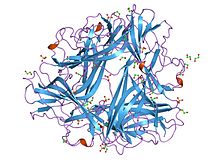- Bacterial adhesin
-
Adhesins are cell-surface components or appendages of bacteria that facilitate bacterial adhesion or adherence to other cells or to inanimate surfaces. Adhesins are a type of virulence factor.
Adherence is an essential step in bacterial pathogenesis or infection, required for colonizing a new host.[1] For example, nontypeable Haemophilus influenzae expresses the adhesins Hia, Hap, Oap and a hemagglutinating pili.
Most fimbriae of gram-negative bacteria function as adhesins, but in many cases it is a minor subunit protein at the tip of the fimbriae that is the actual adhesin. In gram-positive bacteria, a protein or polysaccharide surface layer serves as the specific adhesin. To effectively achieve adherence to host surfaces, many bacteria produce multiple adherence factors called adhesins.
Contents
Dr family
Adhesin_Dr 
drae adhesin from escherichia coli Identifiers Symbol Adhesin_Dr Pfam PF04619 Pfam clan CL0204 InterPro IPR006713 Available protein structures: Pfam structures PDB RCSB PDB; PDBe PDBsum structure summary The Dr family of adhesins bind to the Dr blood group antigen component of decay-accelerating factor (DAF).[2] These proteins contain both fimbriated and afimbriated adherence structures and mediate adherence of uropathogenic Escherichia coli to the urinary tract.[3] They do so by inducing the development of long cellular extensions that wrap around the bacteria.[2] They also confer the mannose-resistant hemagglutination phenotype, which can be inhibited by chloramphenicol. The N-terminal portion of the mature protein is thought to be responsible for chloramphenicol sensitivity.[4] Also, they induce activation of several signal transduction cascades, including activation of PI-3 kinase.[2]
The Dr family of adhesins are particularly associated with cystitis and pregnancy-associated pyelonephritis.[2]
Vaccines
Adhesins are attractive vaccine candidates because they are often essential to infection and are surface-located, making them readily accessible to antibodies.
The effectiveness of anti-adhesin antibodies is illustrated by studies with FimH, the adhesin of uropathogenic Escherichia coli (UPEC). In animal models, passive immunization with anti FimH-antibodies and vaccination with the protein significantly reduced colonization by UPEC.[5] Moreover, the Bordetella pertussis adhesins FHA and pertactin are components of 3 of the 4 acellular pertussis vaccines currently licensed for use in the U.S.
References
- ^ Coutte L, Alonso S, Reveneau N, Willery E, Quatannens B, Locht C, Jacob-Dubuisson F (2003). "Role of adhesin release for mucosal colonization by a bacterial pathogen". J Exp Med 197 (6): 735–42. doi:10.1084/jem.20021153. PMID 12629063. http://www.jem.org/cgi/content/full/197/6/735.
- ^ a b c d Identified Virulence Factors of UPEC : Adherence, State Key Laboratory for Moleclular Virology and Genetic Engineering, Bejing. Retrieved July 2011
- ^ Zhang L, Foxman B, Tallman P, Cladera E, Le Bouguenec C, Marrs CF (June 1997). "Distribution of drb genes coding for Dr binding adhesins among uropathogenic and fecal Escherichia coli isolates and identification of new subtypes". Infect. Immun. 65 (6): 2011–8. PMC 175278. PMID 9169726. http://www.pubmedcentral.nih.gov/articlerender.fcgi?tool=pmcentrez&artid=175278.
- ^ Swanson TN, Bilge SS, Nowicki B, Moseley SL (January 1991). "Molecular structure of the Dr adhesin: nucleotide sequence and mapping of receptor-binding domain by use of fusion constructs". Infect. Immun. 59 (1): 261–8. PMC 257736. PMID 1670929. http://www.pubmedcentral.nih.gov/articlerender.fcgi?tool=pmcentrez&artid=257736.
- ^ Langermann S, Möllby R, Burlein J, Palaszynski S, Auguste C, DeFusco A, Strouse R, Schenerman M, Hultgren S, Pinkner J, Winberg J, Guldevall L, Söderhäll M, Ishikawa K, Normark S, Koenig S (2000). "Vaccination with FimH adhesin protects cynomolgus monkeys from colonization and infection by uropathogenic Escherichia coli". J Infect Dis 181 (2): 774–8. doi:10.1086/315258. PMID 10669375.
Adhesins are also used in cell communication, and bind to surface communicators. Can also be used to bind to other bacteria.
External links
Categories:- Bacteriology
- Virulence factors
- Microbiology
- Cell biology stubs
Wikimedia Foundation. 2010.
